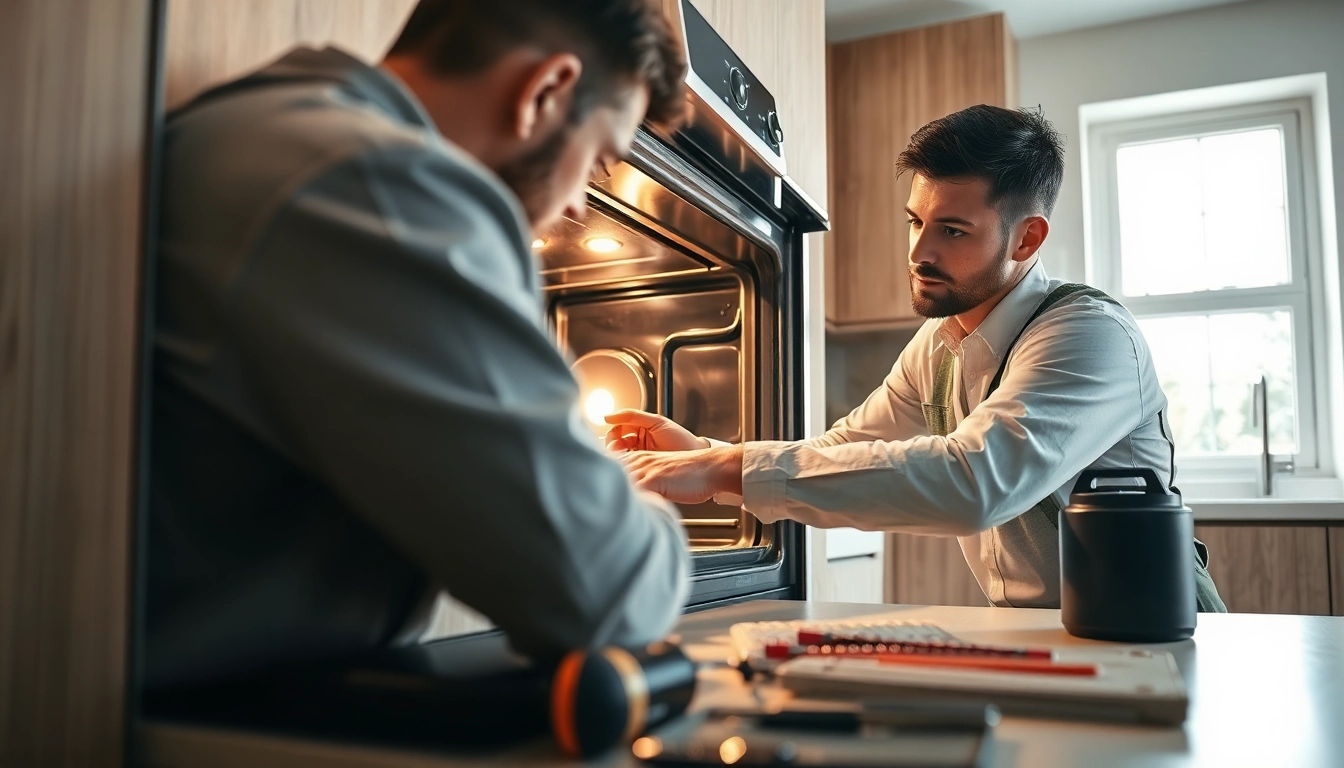Understanding Common Oven Issues
When it comes to maintaining a functional kitchen, the oven is an indispensable appliance. However, like all machines, ovens can succumb to a range of issues over time. Recognizing the symptoms of oven failures early on can save you both time and money. If you’re facing challenges with your oven, it may be time to consider oven repair. This guide aims to delve into common oven problems, the tools you’ll need for repairs, a step-by-step guide to performing maintenance, preventive measures, and tips on evaluating repair costs.
Identifying Symptoms of Oven Failures
Understanding the symptoms of an oven malfunction is crucial for any homeowner. Early detection can lead to timely repairs and an extended lifespan for your appliance. Common indicators that your oven may not be operating correctly include:
- Incorrect temperatures: If your oven isn’t heating to the desired temperature, consider checking its calibration or heating elements.
- Uneven cooking: This can manifest as one side of your food being burnt while the other remains undercooked.
- Strange noises: Any rhythmically clicking, popping, or buzzing sounds could hint at a mechanical failure or issue with the igniter.
- Odors: Unusual smells during operation may indicate a problem with electrical components or food remnants that have baked onto heating elements.
- Error messages: Modern ovens equipped with digital interfaces often display error codes that can lead you to the source of the problem.
Common Problems Leading to Oven Repair
There are several problems that commonly lead to the need for oven repair. These issues often arise from normal wear and tear, improper use, or neglect. Here are some frequent culprits:
- Faulty heating elements: In electric ovens, heating elements can wear out over time, leading to inadequate cooking temperatures.
- Malfunctioning thermostats: Over time, thermostats can misread temperatures, resulting in incorrect cooking temperatures.
- Broken door seals: A faulty door seal can cause heat loss and inefficient cooking.
- Ignition problems: For gas ovens, ignition failures may cause your oven not to light, rendering it unusable.
- Defective control boards: Many modern ovens rely on electronic control boards, and when these fail, the oven may stop functioning altogether.
When to Seek Professional Oven Repair
While many oven repairs can be handled by skilled DIY enthusiasts, some situations require the expertise of a professional technician. Consider calling a professional if:
- You are unsure how to diagnose the problem accurately.
- The repair requires disassembling complex electronic components.
- There are safety risks involved, such as gas leaks in gas ovens.
- Your oven is under warranty, as self-repairs might void it.
Essential Tools for Oven Repair
Must-Have Equipment for Home Repairs
Before tackling an oven repair on your own, it’s essential to acquire a selection of tools that will aid you throughout the process. Having the appropriate equipment at your disposal can make repairs quicker, safer, and more efficient:
- Screwdriver set: A variety of screwdrivers (both flat and Phillips) in multiple sizes is crucial for removing panels and components.
- Multimeter: This tool is essential for testing electrical components and ensuring that power is flowing correctly.
- Socket set: A comprehensive socket set can assist in loosening bolts that hold major components in place.
- Pliers: Both needle-nose and regular pliers will help you in gripping and pulling wires or small components.
- Flashlight: A good flashlight will provide visibility in tight spaces, ensuring you can see what you’re working on.
Safety Gear to Use During Oven Repair
Safety should be a priority when undertaking oven repairs. Here are some essential safety gear items to consider:
- Safety goggles: Protect your eyes from debris, especially when handling electrical components.
- Gloves: Work gloves will protect your hands from sharp edges and electrical shocks.
- Dust mask: Wearing a mask is advisable when working on ovens that may have accumulated dust or debris.
How to Properly Maintain Your Tools
Regular maintenance of your tools is key to ensuring they remain in good working condition. To extend the life of your tools, follow these tips:
- Cleaning: Wipe down tools after use to remove grease or dirt. Store them in a dry environment to prevent rust.
- Sharpening: Periodically sharpen any cutting tools to ensure efficiency and safety during repairs.
- Inspection: Regularly check for wear and tear, replacing any damaged items immediately to avoid compromising your safety and effectiveness.
Step-by-Step Guide to Oven Repair
Preparing for Your Oven Repair
Preparation is crucial before you begin any repair process. Here are key steps to take:
- Unplug your oven: Always ensure the appliance is disconnected from its power source to minimize the risk of electric shock.
- Read the manual: Consult the owner’s manual for specific guidance related to your model, including troubleshooting tips and warranty information.
- Gather materials: Ensure you have all necessary tools and replacement parts ready for the repair process.
Executing Common Repair Techniques
Depending on the specific issue, there are several common repair techniques you might employ:
- Replacing heating elements: Remove the old element by unscrewing it and disconnecting wires. Install the new element by reversing the process.
- Adjusting or replacing the thermostat: Access the thermostat, adjust it calibration, or replace it as indicated in your manual. It’s crucial to ensure it’s correctly positioned after installation.
- Fixing door seals: Inspect the seal for tears or deformities. Remove the old seal and replace it with a new one following the manufacturer’s guidelines.
- Addressing electrical issues: Use a multimeter to test electrical connections and components. Repair or replace faulty wiring as necessary.
Testing Your Oven Post-Repair
Testing your oven after a repair is essential to ensure it functions as intended:
- Calibrate temperatures: Use an oven thermometer to check the accuracy of your oven’s temperature settings.
- Monitor functionality: Cook a simple dish to observe the oven’s performance, ensuring even cooking and proper heating.
Preventive Measures to Avoid Future Repairs
Regular Cleaning and Maintenance Tips
Regular cleaning can significantly enhance the efficiency of your oven and prevent future issues. Consider the following practices:
- Routine cleanings: Wipe down surfaces after each use and perform deep cleans regularly, focusing on spills and food debris.
- Check seals and hinges: Regularly inspect and clean door seals and hinges to ensure they close properly.
- Use proper cookware: Avoid using pans that are too large or incompatible with your oven which can cause overheating or damage.
Signs Your Oven Needs Attention
Recognizing early warning signs can prevent significant damage. Be alert for:
- Odd sounds during operation.
- Unusual smells or smoke.
- Inconsistent cooking results.
How to Extend the Life of Your Oven
To maximize the longevity of your oven, consider implementing the following strategies:
- Regular professional maintenance: Schedule professional check-ups to ensure everything is functioning properly.
- Adhere to usage guidelines: Follow operating instructions provided by the manufacturer to avoid unintentional damage.
- Use surge protectors: To protect against electrical surges that could damage your oven’s control board.
Evaluating the Cost of Oven Repair
Factors Influencing Repair Costs
The cost of oven repair can vary widely based on several factors, including:
- Type of repair: Simple repairs such as replacing a heating element may be less expensive compared to complex issues involving control boards.
- Parts availability: Availability and shipping costs of parts can affect the overall repair cost.
- Labor rates: The cost of labor can differ depending on the technician’s expertise and your location.
Understanding Warranty Options for Repairs
Before investing in repairs, check to see if your oven is still under warranty. Many manufacturers offer limited warranties covering parts and labor for a specified time. Be clear on what your warranty entails, as some conditions may restrict certain types of repairs or DIY alterations.
When to Consider Replacement Over Repair
Sometimes, it may be more cost-effective to replace rather than repair your oven. Consider replacement if:
- The repair costs exceed half the price of a new oven.
- Your oven requires frequent repairs, indicating it may be nearing the end of its lifespan.
- New energy-efficient models are available that could save you money in the long term.


